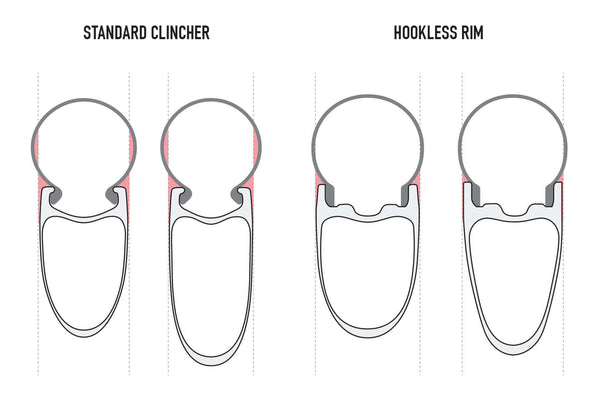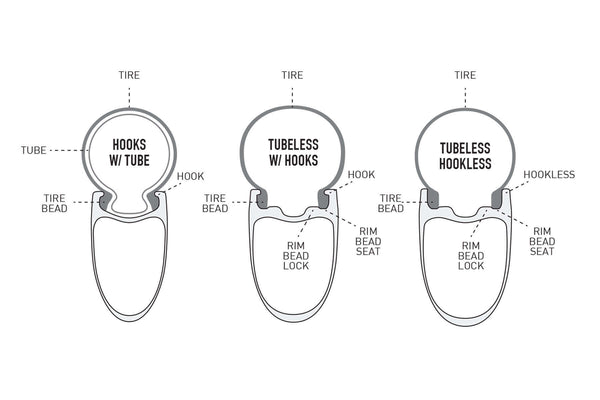No Products in the Cart
While hookless rims have been a fixture in the realm of mountain bikes for an extended period, those involved in the road biking domain have exhibited a certain conservatism, displaying hesitancy towards embracing novel technological advancements.
In recent times, there has been a discernible surge in the adoption of hookless rims in professional road racing circles, gradually garnering acceptance. The pivotal question arises: are hookless rims a worthwhile investment?
Understanding Hookless Rims Hookless rims, in essence, are rims devoid of the conventional hooked shape on the sidewall designed to secure the tire bead.
As illustrated above, the primary distinction between hookless rims and their hooked counterparts lies in the absence of the hook that traditionally secures the tire at the top of the sidewall.

Unveiling the Advantages of Hookless Rims Enhanced Structural Integrity The absence of the hook in the rim's structure renders the carbon fiber more seamlessly continuous (as depicted in the image, preventing undesirable bending of the carbon fiber material), resulting in heightened overall strength and durability of the rim wall. Notably, in scenarios involving low tire pressure, hookless rims exhibit greater resilience when confronted with various surface irregularities.
Expanded Inner Rim Width The non-existence of the hooked structure provides hookless rims with additional space to accommodate the outer tire, resulting in a broader inner rim width. Opting for a smaller tire allows for comparable comfort and grip compared to hooked rims with larger-sized tires. Simultaneously, the absence of the hooked structure contributes to a reduction in weight.
Robust Sidewall Support During Turns The absence of a hooked structure translates to a smoother outer tire sidewall, delivering enhanced sidewall support during turns. This feature contributes to an overall improvement in the tire's cornering performance.
Optimized Aerodynamic Performance In traditional hooked rims, the juncture of the outer tire's sidewall and the rim assumes an S-shape, causing a significant inward shift of the tire near the rim. The outer tire wall of hookless rims, with its closer approximation to a round shape, mitigates this inward shift, resulting in a smoother transition between the hookless rim sidewall and the outer tire wall. This subtle adjustment can marginally enhance the aerodynamic performance of the wheelset (primarily referring to the combined position of the rim and tire).

Tire Installation on Hookless Rims The conventional reliance on rim hooks to secure the tire has ingrained itself as a prevailing notion among riders. There exists a pervasive belief that the interlocking hooks are the sole determinant of the tire-rim combination. Consequently, riders may harbor concerns that hookless rims could lead to tires dislodging easily, posing a potential hazard.
In reality, whether the rim features hooks or is hookless, the interplay between the tire bead, rim bead lock, and rim bead seat extends beyond the hooks. A snug fit between the tire bead, rim bead lock, and rim bead seat ensures effective airtightness, maintaining a close and secure connection between the outer tire and the rim.
In essence, the functionality of hooks can be replicated through the meticulous coordination of the tire bead with the rim bead seat and rim bead lock. Therefore, the elimination of hooks can be exchanged for heightened performance.
The crux of achieving this seamless cooperation lies in the precise coordination of the tire bead size with the rim bead seat, ensuring optimal airtightness. Concurrently, the width of the tire bead should align with the groove of the rim bead lock, preventing the inward shift or dislodgment of the outer tire.
In conclusion, there's no need for undue concern about tire dislodgment when employing a tire compatible with the rim.
Tire and Pressure Recommendations for Hookless Rims The close collaboration between the outer tire and hookless rim is contingent upon the compatibility of the tire and rim, a factor often overlooked in incidents associated with hookless rims. Different brands impose varying requirements regarding the compatibility of their hookless rims and tires. Prospective users should consult the supplier before making a purchase to ascertain which tire models align with their hookless rim.
There exists no strict standard for determining the tire pressure for hookless wheels. Adhering to the tire and pressure recommendations put forth by the manufacturer is imperative to ensure maximal safety and optimal performance.
The merits of hookless rims manifest prominently in their facilitation of superior tubeless tire performance. With correct installation and the use of compatible tires, hookless rims epitomize safety and reliability.
Hookless rims, also referred to as "Straight Side," distinguish themselves by the absence of the small hook at the rim flank's end. The ETRTO officially designates tubeless hookless rims as "TSS," and adherence to ETRTO standards for hookless rims (Straight Side) is imperative.
When pairing tires with rims, it is crucial to abide by the specified maximum pressure for both the tire and the rim. In cases where the rim's specified maximum pressure is lower than that of the tire, the rim's limit must be observed—a guideline specific to tubeless hookless rims (TSS).
Hookless or Straight Side rims should exclusively be paired with TLE/TLR tires (Tubeless Easy/Tubeless Ready). Additionally, users must consider the compatible (tubeless) tire widths outlined by the wheel/rim manufacturer, with special attention to minimum tire widths. This requirement holds true irrespective of the intended use, whether for MTB, gravel/cross, city/tour, or road biking.
The maximum air pressure recommendations for TLE/TLR tires on straight side/hookless rims are categorized based on tire width, as follows:
Distinctive Attributes of Hookless Rims
Reduced Weight: Hookless rims boast a lower weight compared to conventional "hooked" rims, contributing to enhanced overall performance.
Rounded Tire Contour: The absence of the hook in hookless rims results in a rounder tire contour, positively impacting riding characteristics and maneuverability.
Lower Practical Air Pressures: The comparatively high volume of tires on hookless rims allows for significantly lower practical air pressures. This, in turn, enhances overall comfort and grip, providing a notable advantage.